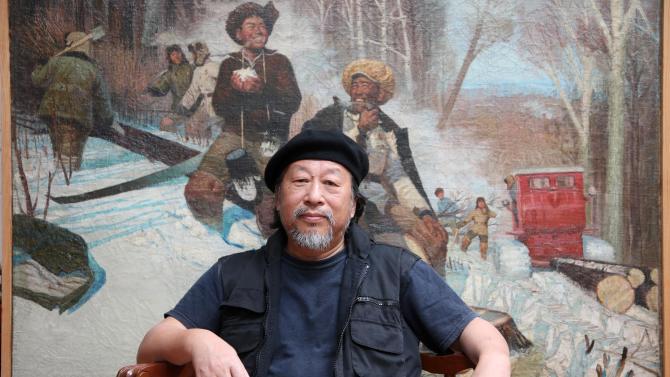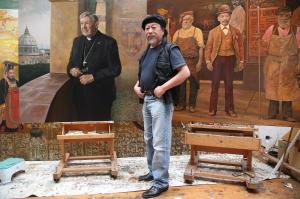Sunday, March 8, 2015
Red Guard propaganda to papal portrait: An artist profile. A perfect example of how the left is never held to account for supporting mass murder
VATICAN CITY (AP) — Artist Shen Jiawei's paintings of Chinese soldiers during the Cultural Revolution were so popular with Mao's regime that 250,000 copies of his most famous work were made into propaganda posters and distributed throughout the country.
Four decades later, Shen now has a different patron commissioning his work: He has become, somewhat inexplicably, the unofficial portrait artist of the Vatican. He painted the first official portrait of Pope Francis and recently completed a huge rendition of the second most powerful man in Rome, Cardinal George Pell, the Vatican's money guy.
Shen's journey from favored propaganda artist of the People's Liberation Army to papal portraitist is an unusual tale of talent and timing. It's a journey that took Shen from China to Australia, where he charged tourists $30 a pop for portraits in Sydney's Darling Harbour, and most recently to a balcony in the Vatican gardens where he sketched Pell.
"For me, one door closed but another always opened," Shen, 66, said of his career in a recent phone interview from his studio in Bundeena, south of Sydney.
Shen was in his final year in high school when Mao Zedong launched the Cultural Revolution, the 1966-1976 campaign to restore ideological purity to China's anti-capitalist revolution.
His hopes of attending art school dashed with the closure of China's universities, Shen joined the Red Guards and then the People's Liberation Army, fully embracing the communist spirit of the times. In the PLA, his self-taught artistic talents were recognized and he became one of the legions of propaganda artists who glorified workers, farmers and soldiers in the Socialist Realism style of Soviet propaganda.
In 1974, during a tour of duty in remote Heilongjiang Province, Shen painted his most famous work, "Standing Guard for Our Great Motherland," featuring three soldiers guarding the Sino-Soviet border from a watchtower. The piece was included in a 1974 exhibition at the National Art Museum in Beijing that was organized by Mao's wife, who personally praised it.
Shen recalls, though, that when he eventually saw it hanging in the museum, he was stunned: The soldiers' faces had been altered to adhere to the regime's standards for revolutionary art: Their faces were fatter and redder to make them appear more healthy and heroic.
With the more robust soldiers in place, the picture was reproduced and turned into propaganda posters and Shen shot to fame; in the 1970s and '80s, he was one of the best-known artists in China.
"Lots of our generation copied his paintings," said fellow Chinese-born, Australian artist Guo Jian, 53, who also was a PLA propaganda artist but later joined the pro-democracy student protest movement that culminated with the 1989 Tiananmen Square crackdown.
"When we grew up in that time, there was nothing else" but propaganda art, Guo said. "He has a really great skill, and the way he painted, you can see he's slightly different from the others. I think that's what impacted us."
Today, Shen is proud of his work — not because it was good propaganda, but because he managed to become an artist in China at a time when oil paints were otherwise nearly impossible to obtain. He says he didn't sell out to the idealized standards of propaganda art that most other Chinese artists copied. Instead, he says he relied on nature to guide his brush.
"This is why today if you look back at that time, in China, most artwork is different than mine," he said. "I'm proud of that."
He similarly doesn't see his new works of Pope Francis and his No. 2 as propaganda for the Catholic Church.
"I stopped my propaganda work in the 1970s," he said, laughing. "Even church commission work, this is part of normal artwork, part of commission and part of history."
Shen first caught the attention of Australian church officials with a 1994 portrait of Mary MacKillop, the 19th-century nun who ministered to the poor and in 2010 became Australia's first saint.
The portrait won Shen an important Australian art award named for the nun and enabled him to meet St. John Paul II during his 1995 visit to Australia when he beatified MacKillop.
Shen got the commission to paint Francis in August 2013, just a few months after Francis became pope. Francis didn't sit for the portrait, but the Vatican offered up official photos for Shen to use.
Shen painted Francis with outstretched arms, a white dove about to land on his shoulder. He is surrounded by people Shen painted from the photos of crowds at papal audiences, slipping in an image of his daughter for fun. There are several birds in the painting, homage to Francis' namesake, the nature-loving St. Francis of Assisi.
"When the pope approved this project and they sent me the photos, (they said) the pope wants a painting with people together," Shen said.
The painting now hangs in a villa in the Vatican gardens that houses the Pontifical Academy for Sciences, which deals with Francis' pet projects on human trafficking, slavery and youth culture, among other issues.
The portrait of Pell, commissioned by a Catholic university, is a more classic portrait, featuring the Australian prelate looking out over St. Peter's from a tiled terrace.
Geoff Raby, Australia's former ambassador to China who has a print of Shen's "Standing Guard" in his collection of propaganda art, said Shen's portrait career is a natural progression from the propaganda art and historical paintings that he is most famous for.
"He's painting subjects that he has philosophical connection to and sympathy with," Raby said in a phone interview. But he added: "He also has an eye to commercial reality."
___
Labels:
China,
class warfare,
Communism,
Mass Murder,
the arts
Subscribe to:
Post Comments (Atom)












No comments:
Post a Comment